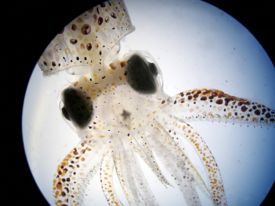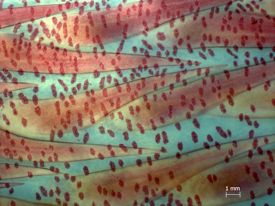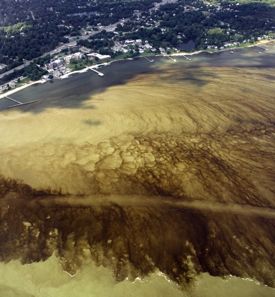VIMS announces winners of 2013 Photo Contest
Winning entries range from cellular to watershed scale
The Virginia Institute of Marine Science has announced the winners of its 14th annual photo contest, an in-house competition held to recognize and honor the most captivating images taken by VIMS faculty, students, and staff during their scientific work in the field and laboratory.
The first-place winner for 2013 is Master’s student Brendan Turley, for his photograph of a juvenile squid (Lolliguncula brevis). Turley captured the image with a dissection microscope after catching the creature in a trawl net during a field trip to VIMS’ Eastern Shore Lab. The annual excursion helps introduce new students in William & Mary’s School of Marine Science at VIMS to the pristine barrier-island ecosystem of Virginia’s Eastern Shore.
 Taking second-place was Master’s student Emily Loose for her photo—another microscope-derived shot—showing a patch of cleared and stained scales sampled from a white marlin (Kajikia albida) caught during a fishing tournament in Ocean City, Maryland. Loose is studying scale patterns in white marlin and roundscale spearfish to see if they can help distinguish between these similar and often-confused species. Her work is part of Dr. John Graves’ on-going efforts to use genetic analysis and other techniques to better understand the movements, habitat use, and post-release survival of open-ocean fishes, all with an eye to better management.
Taking second-place was Master’s student Emily Loose for her photo—another microscope-derived shot—showing a patch of cleared and stained scales sampled from a white marlin (Kajikia albida) caught during a fishing tournament in Ocean City, Maryland. Loose is studying scale patterns in white marlin and roundscale spearfish to see if they can help distinguish between these similar and often-confused species. Her work is part of Dr. John Graves’ on-going efforts to use genetic analysis and other techniques to better understand the movements, habitat use, and post-release survival of open-ocean fishes, all with an eye to better management.
The third-place winner was Professor Wolfgang Vogelbein, for his aerial image of a harmful algal bloom in the York River. He took the photo on August 22nd of this year during an over-flight piloted by Daniel Hirtenstein, a graduate student in the Chemistry Department at W&M. Field samples show the bloom was dominated by Cochlodimuim polykrikoides and Alexandrium monilatum.  The latter is a chain-forming dinoflagellate that is thought to be responsible for the death of numerous experimental animals at VIMS exposed to York River water during blooms in 2007 and 2008. No fish kills or human-health effects were reported during this year’s late-summer blooms. Both Vogelbein and fellow VIMS professor Kim Reece are members of Virginia’s Harmful Algal Bloom Task Force.
The latter is a chain-forming dinoflagellate that is thought to be responsible for the death of numerous experimental animals at VIMS exposed to York River water during blooms in 2007 and 2008. No fish kills or human-health effects were reported during this year’s late-summer blooms. Both Vogelbein and fellow VIMS professor Kim Reece are members of Virginia’s Harmful Algal Bloom Task Force.
The selection committee, headed by VIMS Publications Manager Sue Stein, also awarded six honorable mentions:
- Solomon Chak—a field study in Panama designed to study the migration patterns of snapping shrimp
- Christopher Davis—seining on the Rappahannock River as part of VIMS’ Juvenile Striped Bass Seine Survey
- Jenny Dreyer— REU students Hannah Erhmann and Martin Wong retrieving a trawl net from the waters of Virginia’s Eastern Shore.
- Patricia O’Leary—micrograph of Hematodinium perezi, a blue crab parasite under study at VIMS
- Josh Stone—a curious and well-camouflaged Adélie penguin investigates a Zodiac during the 2012-13 PAL-LTER field season
- Wolfgang Vogelbein—bioluminescence captured on a York River shoreline during a bloom of Alexandrium monilatum in 2011
 Stein says that she "always appreciates the efforts of those who submit their photos to our contest," and notes that VIMS uses photo-content entries to help illustrate its print publications, outreach materials, and website.
Stein says that she "always appreciates the efforts of those who submit their photos to our contest," and notes that VIMS uses photo-content entries to help illustrate its print publications, outreach materials, and website.
VIMS Dean and Director John Wells says he enjoys the photos for their "engaging depiction of the wide diversity of research activities pursued by VIMS scientists in Chesapeake Bay and around the world."
High-resolution versions of the images are available on the VIMS Flickr page at http://bit.ly/vimsphotocontest13
